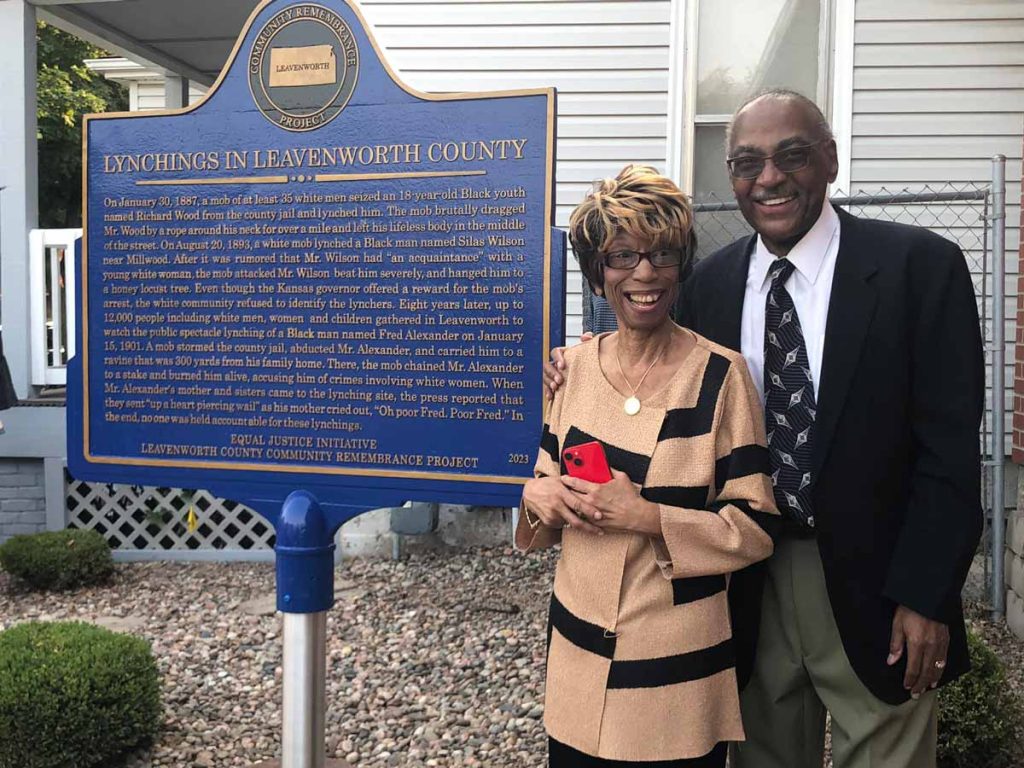Community members gathered at Bethel AME Church in Leavenworth, Kansas, on June 16 for a dedication ceremony and unveiling of a historical marker honoring Richard Wood, Silas Wilson, and Fred Alexander, three Black men who were lynched in Leavenworth County.
Located at the Richard Allen Cultural Center & Museum Garden, the marker is the latest of dozens of historical markers erected across the country as part of EJI’s Community Remembrance Project.
Local community members organized a coalition in 2020 to confront their community’s history of racial terror lynchings. In partnership with EJI, they held a community soil collection ceremony last year.
Lynchings in Leavenworth County
On January 30, 1887, a mob of at least 35 white men seized a Black 18-year-old named Richard Wood from the county jail and lynched him. The mob brutally dragged Mr. Wood by a rope around his neck for over a mile and left his lifeless body in the middle of the street.
On August 20, 1893, a white mob lynched a Black man named Silas Wilson near Millwood. After it was rumored that Mr. Wilson had “an acquaintance” with a young white woman, the mob attacked him, beat him severely, and hanged him to a honey locust tree.
Even though the Kansas governor offered a reward for the mob’s arrest, the white community refused to identify the lynchers.
Eight years later, up to 12,000 people, including white men, women, and children, gathered in Leavenworth to watch the public spectacle lynching of a Black man named Fred Alexander on January 15, 1901.
A mob stormed the county jail, abducted Mr. Alexander, and carried him to a ravine that was 300 yards from his family home. There, the mob chained Mr. Alexander to a stake and burned him alive, accusing him of crimes involving white women.
When Mr. Alexander’s mother and sisters came to the lynching site, the press reported that they sent “up a heart piercing wail” as his mother cried out, “Oh poor Fred. Poor Fred.” In the end, no one was held accountable for these lynchings.
The community also acknowledged the unjust incarceration and death of Margaret “Sis” Vinegar, who was imprisoned and died in custody shortly after her arrest following the lynching of her father, Pete Vinegar, and two other Black men, Isaac King and George Robertson.
Community Remembrance Project
The Community Remembrance Project is part of EJI’s campaign to recognize the victims of lynching and advance honest conversation about the legacy of racial terror by collecting soil from lynching sites, erecting historical markers, and inviting community members to visit the Legacy Museum and National Memorial for Peace and Justice in Montgomery, Alabama, where the horrors of these racial injustices are acknowledged.
Through the Community Remembrance Project, EJI has joined with dozens of communities to install historical markers where the history of lynching is documented in our effort to help towns, cities, and states confront and recover from tragic histories of racial violence and terrorism.
We believe that understanding the era of racial terror is critical if we are to confront its legacies in the challenges that we currently face, from mass incarceration, excessive punishment, and police violence to the presumption of guilt and dangerousness that continues to burden people of color today.

/
Jars with soil collected in honor of Fred Alexander, Richard Wood, and Silas Wilson, three Black men who were lynched in Leavenworth County.
KMBC
/
Kansas Court of Appeals Judge Richard Green and his wife Shirley attended the marker unveiling ceremony.
Chief Judge Karen Arnold-Burger
/
Community members gathered to honor the three men lynched in Leavenworth County during a ceremony on June 16, 2023.
Micah Bray
/
The marker now stands at the Richard Allen Cultural Center in Leavenworth.
Sean CrittendonLynching in America
Between 1865 and 1950, at least 6,500 Black people were victims of lynchings in the U.S.
Kansas was established as a free state in 1861, but many white people remained committed to white supremacy and opposed equal rights for Black people.
After the Civil War, emancipated Black people migrated to Kansas in pursuit of their freedom and newfound rights as citizens, only to be met with ongoing bigotry and abuse. White mobs seeking to enforce racial hierarchy resorted to terror and violence to intimidate and oppress Black communities.
Lynching emerged as the most notorious and public form of racial terrorism. Public spectacle lynchings, like the lynching of Fred Alexander, were often committed in prominent locations and attended by hundreds to thousands of white men, women, and children without fear of legal repercussions.
White mobs displayed complete disregard for the legal system by seizing Black people from jails, prisons, courtrooms, and directly out of police hands. Law enforcement officers, though armed and responsible for protecting Black citizens, frequently failed to intervene. White officials routinely granted mobs impunity as they tolerated—and at times, participated in—these lawless killings of Black men, women, and children.
Although many lynching victims will never be known, at least 22 lynchings have been documented in Kansas, with at least three known to have taken place in Leavenworth County.